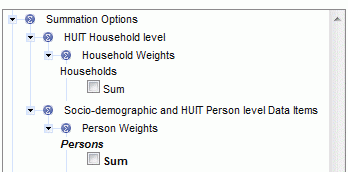Generally, the Socio–demographic and HUIT Person Level relates to people so a person weight is attached to this level in the Summation Options. The HUIT Household Level relates to households so a household weight is attached to this level.
The default weight when producing any table using the HUIT TableBuilder is the person weight (in bold in the image above). This weight is automatically applied to any table being generated. A weight in bold, such as in the image above, indicates the weight being used in the table. This weight can be changed through Summation Options. Placing a tick in a 'Sum' tick box and then adding it to a row or column in the table will select a different weight.
While the default is person weight, if it is not shown in bold it can be selected through Summation Options. To estimate the number of persons with certain characteristics (e.g. 'Activities of Internet access at home') the weight listed under the category heading Socio–demographic and HUIT Person Level must be used. To specifically select a person weight through Summation Options:
- Click on the blue triangle 'twistie' next to the Summation Options line
- Ensure all 'Sum' tick boxes are blank
- Click on the Socio–demographic and HUIT Person Level 'twistie'
- Click on the Person Weight 'twistie'
- Click on the Sum tick box
- Add the person weights to your table by clicking on add to row or add to column
To estimate the number of households with certain characteristics (e.g. 'Main type of broadband Internet access') the weight listed under the category heading HUIT Household Level must be used. The same process as above can be followed, ticking the 'Sum' tick box under the HUIT Household Level 'twistie' instead.
The weights that should be used for each data item are shown in the data item list, which can be accessed from the Data downloads section.




